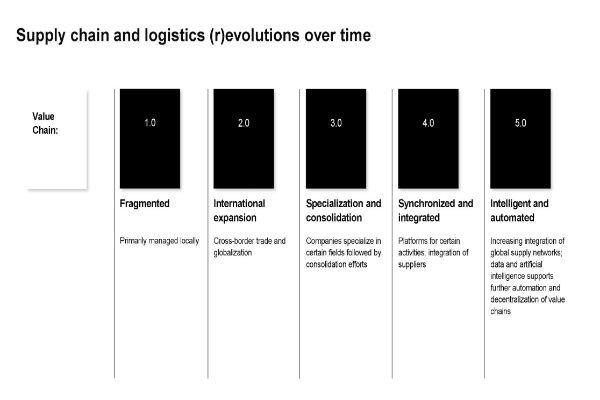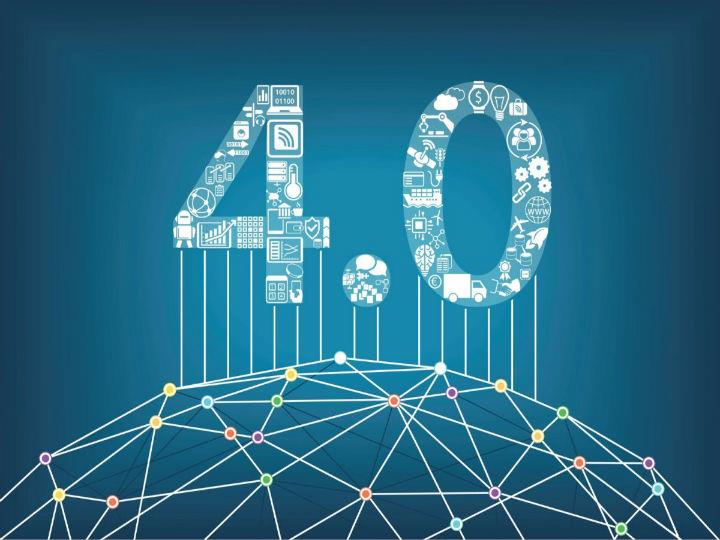by Wolfgang Lehmacher*
The Fourth Industrial Revolution is the accelerated development and convergence of the physical, digital and biological spheres. The revolution comes along with the digital transformation of the economy and society. No industry can escape. The conversation in the supply chain and logistics industry about the why, what and how have matured. Today, these are informed, pragmatic and based on use-cases. My nonacademic estimate is that decision makers in the public and private sectors are 80 percent conscious about the why they should digitize, 40 percent certain about what they should focus on, and 20 percent clear on the how to digitize. Yet, the average supply chain digitization is 43 percent – the lowest of five business areas assessed by McKinsey.
In transport, we moved from wind-powered, to steam powered and oil-powered shipping, to satellite guided navigation, and now we are at the beginning of the emergence of networks of autonomous vehicles. The four industrial revolutions overlay and sometimes we move back to previous inventions, like the sail in ocean shipping. Also, the logistics industry has been coming a long way, from locally managed assets and capabilities in the 1940th, 50th and 60th, to massive internationalization in the 70th and 80th, to specialization and consolidation in the 90th. Supply chain and logistics 4.0 “in the making” is about to bring integration and synchronization as the basis for logistics 5.0 which is about intelligence and large-scale automation.

Developing the business ecosystem is the central philosophy behind digitization. Digital platforms are allowing the various stakeholders to expose their capabilities and leverage the capabilities of other parties, driving higher levels of business value. The new world includes internet of things (IoT) platforms, customer experience platforms, data and analytics platforms, information systems and ecosystem platforms. The most common platform is the marketplace, established by the likes of Amazon and Alibaba. The first step in the process of digital value creation is gathering, generating and aggregating data to realize the complete end-to-end replica of the supply chain and logistics chain. This includes the data that informs the system about the behavior of the stakeholders and the position of the assets within. Data allows to describe what has happened or is happening, to predict what will happen and to prescribe what the system should be doing to avoid a failure or disruption. Automated systems execute on the recommendations resulting from the data analysis – hopefully in the most sustainable way. Hence, the next phase of the Fourth Industrial Revolution will be largely about marketplaces, data analytics, automation and green tech.
Marketplaces
Seven of the world’s 10 most valuable companies operate a platform-based business model – among these players are Amazon, Google, Alibaba and Tencent. The logistics industry’s first unicorn, the digital forwarder Flexport, is also a platform-based business. Traditional logistics companies from Kuehne & Nagel to DB Schenker, from Agility to DSV are also digitizing their business. The minimum forwarders and carriers can do, is to develop system and platform management solutions to interact and transact with other digital players. Platforms like US-based Uber Freight or Dutch Quicargo, a company I am working with, entered the market. While some platforms are building their customer and supplier base, others are working on creating the “ring that rules them all”, i.e. the management system that can leverage the capabilities of the digital platforms on the market. This development is not limited to the so-called "uberization" of the trucker market. Also, the Airbnb of warehousing has emerged. In the United States of America through Flexe, and in Europe Stockspots.
Taking paper out helps to eliminate error, reduce time and cost. Companies, like shippers, forwarders and carriers, can leverage platforms to standardize their data sets and their processes. Platforms offer analytics to turn data into structured reports, predictions and recommendations. Platforms don’t aggregate only the data of one company, but of the many parties engaged with them. This allows the platforms to produce benchmarks, indices and understand and predict market trends.
Data analytics
Some years ago, technology company Flex established the Pulse Centre to monitor the flow of goods, while constantly analyzing the situation in the ecosystem to analyze potential disruptions, for example caused by weather or strikes. Pressure on compliance with laws and regulations is steadily increasing. IoT platforms fed by sensors and equipped with analytics enable constant monitoring. But, also internal benchmarking of suppliers, routes and vehicle performance. It is these datasets combined with analytics which is the prerequisite of fact-based planning and real-time management of the supply chain. But it is not the end-to-end visibility that counts but the extraction of the relevant information which drives learning and innovation and assist to avoid delays, damage and disruptions.
Automation
Automation falls short in a chain that isn’t integrated and synchronized. Automated terminals bring a new standard. They offer consistency, precision and safety. However, if they operate in isolation and without larger integration, they may be less efficient than non-automated terminals. It is through the continuous flow of containers that the automated terminals produce the expected results. The same is the case with autonomous vehicles on the roads of our cities. A study of the World Economic Forum in collaboration with Boston Consulting Group (BCG) showed that autonomous vehicles have the highest impact in a purely autonomous environment. Once the autonomous vehicles get mixed with traditional mobility the system gains start diminishing.
Recently, robotic process automation (RPA) has moved into the spotlight. RPA is artificial intelligence that works with computer software to perform repetitive, detailed administrative tasks ranging from data cleansing to preparation of documents to digital interactions with costumers. According to a report by research firm Gartner, 73 percent of corporate controllers will be using some form of robotic automation by 2020. RPA increases efficiency by reducing processing and communication time as well as human error. The software bots work consistently – 24/7. As RPA learns steps and rules, the technology works with existing legacy software solutions and systems. Distributed ledger technology (DLT), like blockchain is helping automating supply chain and logistics processes too. Through smart contracts that execute payments when agreed terms and conditions are met. The required data can be gathered for example through IoT devices.
Green tech
In December 2015, the United Nations COP21 Paris Accord committed participating countries to keeping the temperature increase well below 2 degrees centigrade. Aviation and ocean shipping were excluded from this agreement. The aviation sector achieved its carbon deal on 6 October 2016 and the shipping industry theirs on 13 April 2018. The shipping lines are investing in developing and deploying energy efficiency solutions to meet the targets. The measures include the retrofitting of new bulbous bows and propellers, as well as engine modifications. However, experts say that the technology to achieve the required emission reduction targets still falls short. The innovation required needs more collaboration across the maritime ecosystem to agree for instance on standards that will give manufacturers more comfort to make the high investments in developing more effective decarbonization technologies.

With digitization, security needs are rising. Gartner cyber-security experts estimate that global spending on information technology (IT) security will jump 8.7% in 2019 up to $124 billion, while general IT spending is expected to grow by only 3.2%. 60 percent of C-level executives believe that their current company solutions protect them well enough against security threats. Only 29 percent of IT experts agree with this assessment. Studies of data breaches reveal that 70 percent of incidents are caused by people and process failures. This shows that effective protection does not only require technology, but the review of procedures and processes and collaboration across the global supply chain and logistics ecosystem.
The organizations that thrive in the digital era turn products into platforms, establish seamless strings of growing data-sets and transform these into intelligence. Smart companies will find new opportunities and ways to become emission neutral. Their supply chains are resilient. Finding winning technology will become easier through market consolidation. However, the top performers understand that it is not at all about technology but people and partnerships. Because at the end, the transformation comes only through them and will last only if it is designed for the people.
*Strategic Advisor and Business Angel
**first published in: www.linkedin.com




 By: N. Peter Kramer
By: N. Peter Kramer
